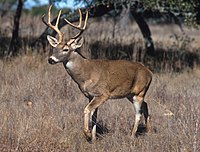
Photo from wikipedia
Spatio-temporal patterns of the spread of infectious diseases are commonly driven by environmental and ecological factors. This is particularly true for vector-borne diseases because vector populations can be strongly affected… Click to show full abstract
Spatio-temporal patterns of the spread of infectious diseases are commonly driven by environmental and ecological factors. This is particularly true for vector-borne diseases because vector populations can be strongly affected by host distribution as well as by climatic and landscape variables. Here, we aim to identify environmental drivers for bluetongue virus (BTV), the causative agent of a major vector-borne disease of ruminants that has emerged multiple times in Europe in recent decades. In order to determine the importance of climatic, landscape and host-related factors affecting BTV diffusion across Europe, we fitted different phylogeographic models to a dataset of 113 time-stamped and geo-referenced BTV genomes, representing multiple strains and serotypes. Diffusion models using continuous space revealed that terrestrial habitat below 300 m altitude, wind direction and higher livestock densities were associated with faster BTV movement. Results of discrete phylogeographic analysis involving generalized linear models broadly supported these findings, but varied considerably with the level of spatial partitioning. Contrary to common perception, we found no evidence for average temperature having a positive effect on BTV diffusion, though both methodological and biological reasons could be responsible for this result. Our study provides important insights into the drivers of BTV transmission at the landscape scale that could inform predictive models of viral spread and have implications for designing control strategies.
Journal Title: Proceedings of the Royal Society B: Biological Sciences
Year Published: 2017
Link to full text (if available)
Share on Social Media: Sign Up to like & get
recommendations!